
Pseudotsuga is a genus of evergreen coniferous trees in the family Pinaceae. Common names for species in the genus include Douglas fir, Douglas-fir, Douglas tree, Oregon pine and Bigcone spruce. Pseudotsuga menziesii is widespread in western North America and is an important source of timber. The number of species has long been debated, but two in western North America and two to four in eastern Asia are commonly acknowledged.

Peavy Arboretum is an arboretum operated by Oregon State University and located on Arboretum Road, Corvallis, Oregon. It is open to the public daily without charge.
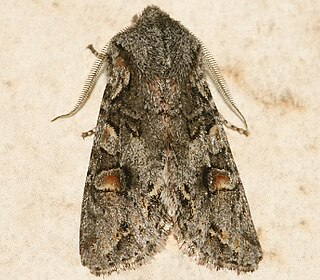
Egira hiemalis is a moth of the family Noctuidae. It is found in western North America from British Columbia south to California.

Protoboarmia porcelaria, the porcelain gray or dash-lined looper, is a Geometrid species of moth found throughout North America, except in the far north. The species was first described by Achille Guenée in 1857.

Lasionycta sasquatch is a moth of the family Noctuidae. It is found in the Washington Cascades south of Snoqualmie Pass, Saddle Mountain in the Oregon Coast Range, and the Siskiyou Mountains in south-western Oregon.
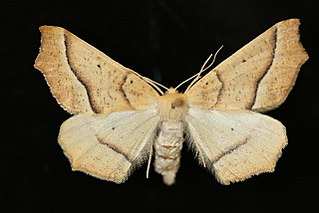
Tetracis pallulata is a moth of the family Geometridae first described by George Duryea Hulst in 1887. It is found in western North America from southern California north to British Columbia, east to Idaho and western Montana from near sea level to 2,200 meters.
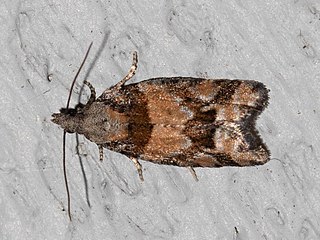
Epinotia radicana, the red-striped needleworm moth, is a species of moth of the family Tortricidae. It is found in western Canada, including British Columbia and Alberta.
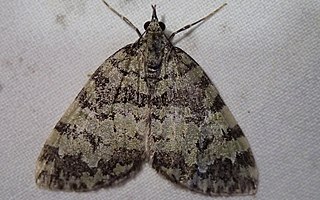
Hydriomena speciosata is a moth of the family Geometridae. It is found from coastal British Columbia south to California. The habitat consists of wet conifer forests.

Nepytia umbrosaria is a moth of the family Geometridae first described by Alpheus Spring Packard in 1873. It is found in North America, including Arizona, British Columbia, California, Oklahoma, Oregon and Washington.

Eupithecia placidata is a moth in the family Geometridae first described by Taylor in 1908. It is found in western North America from British Columbia south to California.
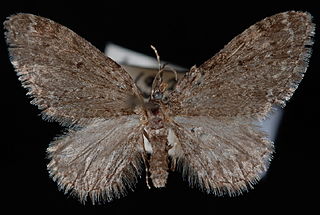
Eupithecia annulata, the larch pug moth, is a moth in the family Geometridae. The species was first described by George Duryea Hulst in 1896. It is found in North America from British Columbia north to the Yukon, east to Newfoundland and Labrador and south to California and Colorado.

Eupithecia olivacea is a moth in the family Geometridae first described by Taylor in 1906. It is found in North America from British Columbia south through Washington and Oregon to California.
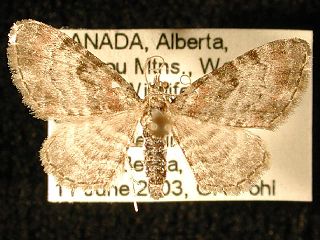
Eupithecia albicapitata is a moth in the family Geometridae first described by Alpheus Spring Packard in 1876. It is found from Newfoundland and Labrador to western British Columbia, north to Alaska and Alberta, south to New England and New York.

Argyrotaenia provana is a species of moth of the family Tortricidae. It is found in North America, where it has been recorded from Arizona, British Columbia, California, Colorado, New Mexico, Utah, Washington and Wyoming.
Argyrotaenia occultana, the fall spruce needle moth, is a moth of the family Tortricidae. The species was first described by Thomas Nesbitt Freeman in 1942. It is found in North America, where it has been recorded from British Columbia north to Yukon and Northwest Territories, east to Newfoundland and south to Kentucky and Oregon. The habitat consists of spruce forests.
Choristoneura carnana is a species of moth of the family Tortricidae first described by William Barnes and August Busck in 1920. It is found in the United States, where it has been recorded from California and Colorado.
Choristoneura retiniana is a species of moth of the family Tortricidae. It is found in the United States, where it has been recorded from California and Nevada.
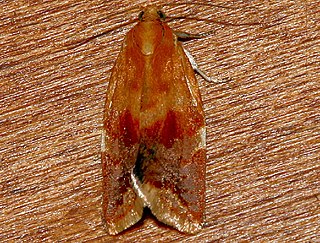
Clepsis persicana, the white triangle tortrix or the green needleworm, is a species of moth of the family Tortricidae. It is found in North America, where it has been recorded from Alaska and British Columbia to Newfoundland and south to Virginia and west to California. The habitat consists of coniferous and mixed coniferous forests.

Syndemis afflictana, the gray leafroller, dead leaf roller or black-and-gray banded leafroller, is a species of moth of the family Tortricidae. It is found in North America, where it has been recorded from southern Canada and the northern United States. In the west, the range extends south in the mountains to California. The species is also present in Florida. The habitat consists of coniferous forests.
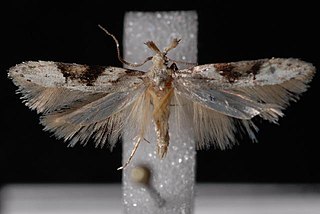
Coleotechnites atrupictella is a moth of the family Gelechiidae. It is found in North America, where it has been recorded from Alberta, British Columbia, Indiana, Maine, Massachusetts, Michigan, New Brunswick, Newfoundland, New York, Ontario, Pennsylvania, Saskatchewan and Washington.
















